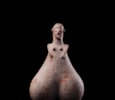Steatopygous Idol
This magnificent idol is an exceptional example of Amlash ceramic sculpture. The curves of the unmistakably female form are strongly steatopygous. Full hips swell, fecund, below narrow shoulders. The figure is nude, the limbs stylized and rounded. Two arms rest upon the chest and below the breasts. Large, high, rounded buttocks extend from behind. She stands on circular pad feet. Five incised lines decorate the neck, probably representing jewellery, and her ears protrude from a headdress. The ears are pierced, and might possible have been decorated with earrings originally, as is the case with some Amlash bulls. The piece has the squat femininity often found in very early sculpture, and possesses all the mystery and allure of spiritualised fertility. It recalls much earlier Neolithic figurines in its simplicity. Decontextualization makes the exact function of such idols unknown, however, given the number of similar figures found in the same area and indeed her form itself, a religious, possibly apotropaic reading, as a goddess, worshipper or protector, seems most apt.
‘Amlash Sculpture from Iran’, Betty Parsens Gallery, 24 West 57th Street, New York, 23rd September - 19th October 1963.
Advertising Poster, Amlash Sculpture from Iran, Betty Parsons Gallery, New York, 1963.
Boisgirard Paris, Bronzes et terres cuites du Louristan et de la Caspienne, 26 September 1980, lot 15 (illus.)
G. Fehe´rva´ri et al., Art of the Eastern World, Hadji Baba Ancient Art, London, 1996, p. 28, no. 11.
David Aaron Ltd, 2022, No. 5.
Previously in a Private Collection, from at least 1963, most likely that of Samuel Dubiner (1914-1993), Tel Aviv, Israel, as most if not all of the Amlash artworks that were in the famous 1963 exhibition were consigned from his collection.
With Betty Parsons Gallery (24 West 57th Street, New York), 1963.
In the Private Collection of Mehdi Mahboubian, from at least 1980.
Sold at: Boisgirard Paris, Bronzes et terres cuites du Louristan et de la Caspienne, 26 September 1980, lot 15 (illus.), consigned from the above under pseudonym ‘collection X’.
With Hadji Baba Ancient Art, London, likely acquired at the above sale.
With Sakae Art Gallery, Japan.
With Lord Anthony Jacobs (1931-2014) collection, London, acquired from the above 3rd August 1995 (with copy of the invoice).
ALR: S00210851, with IADAA certificate, this item has been searched against the Interpol database.
Betty Parsons (1900-1982) was an American artist, art dealer, and collector known for her early promotion of Abstract Expressionism. She is regarded as one of the most influential and dynamic figures of the American avant-garde.
Parsons was referred to as "the den mother of Abstract Expressionism," and was an early advocate of the great Abstract Expressionists - Pollock, Rothko, Reinhardt, Still, and Newman - long before they all achieved notoriety. Her midtown gallery, which opened in 1946 (and closed every summer so that Parsons could focus on her own art), gave the Abstract Expressionist artists their first large-scale exposure, making it one of the most prestigious art galleries in New York. In its later years, the Parsons Gallery did much to promote the works of many gay, lesbian and bisexual artists, including Agnes Martin, Ellsworth Kelly, Jasper Johns and Robert Rauschenberg.
The Betty Parsons Gallery’s first exhibition, in September 1946, was organized together with Barnett Newman and Tony Smith. Newman, who wrote for many of the catalogues on behalf of the Gallery, noted, “It is becoming more and more apparent that to understand Modern art, one must have an appreciation of the primitive arts, for just as modern art stands as an island of revolt in the stream of western European aesthetics, the many primitive art traditions stand apart as authentic aesthetic accomplishments…”
Betty Parsons strove to turn her gallery into more than just a home for New York's avant-garde. She set out to create a haven for those artists who received less recognition - particularly women and the gay community - during a time when the art world remained dominated by straight men. While her gallery was not among the wealthiest of New York galleries, or among the most elite, it did develop a reputation for being the definitive place where some of the 20th-century's greatest artists got their start. Even after some of them left for bigger galleries and dealers (about which she was reportedly offended), Parsons remained proud of the legacy she worked to create.
Lord Anthony Jacobs (1931-2014) was a British businessman and an independent politician. Jacobs was Chairman of Nig Securities Group from 1957-1972, of Tricoville Group from 1961-1990 and 1992-1994, and of the British School of Motoring from 1973-1990. From 1972, he was member of the Liberal Party and in 1984 he became his Party's Joint Treasurer. He was knighted in 1988, and in 1997 he was created a life peer as Baron Jacobs of Belgravia in the City of Westminster. At the time of his peerage, he also received an Honorary Doctorate from the University of Haifa in recognition of his generous support for the excavation of an ancient shipwreck at Ma'agan Michael.










 Enquire
Enquire




